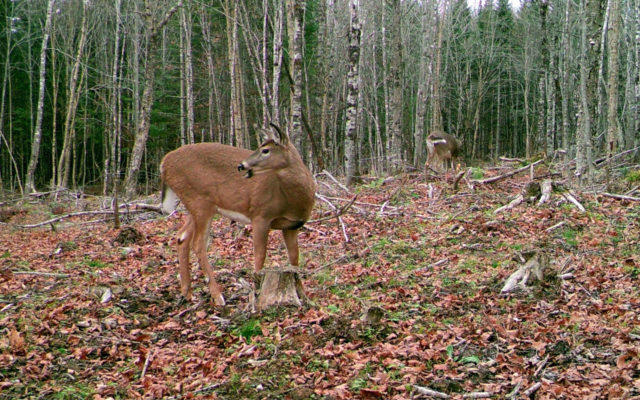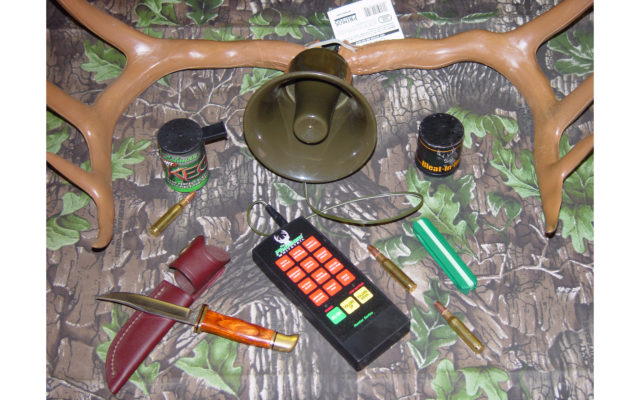Maine’s habitat of heavy forest, especially throughout Aroostook County, has dictated the most productive styles of deer hunting since the early 1900s.
Our fathers and grandfathers put much-needed venison in the icebox using walk and stalk tactics. The techniques of “still hunting” — slowly and quietly wandering the woods along obvious deer trails or finding and following a fresh set of tracks — still works over a hundred years later.
- The doe in the foreground stopped to return a grunt to a hunter calling from a tree stand nearby, while the deer in the background ignored the call, deer calls and rattling antlers really do attract whitetails. (Courtesy of Bill Graves)
Decades of heavy lumbering and the creation of thousands of new agri-fields all over the Crown of Maine have opened the door to other successful styles to bag a buck. Fifty years ago, sitting on a stump overlooking a fresh cut became popular. More recently, however, erecting a tree stand or setting up a portable ground blind along the edge of often used game trails, feed fields, wild apple orchards and beech ridges and fresh scrapes and rubs are more popular, and effective.
The one characteristic all of these options require is silence. Hunters need to be hidden, motionless, scent free, patient and above all, quiet. Well, guess what? There’s a new game in The County, imported from out West, and it actually uses noise to bring deer to the hunter rather than the silent, sit-and-wait option. More and more whitetail enthusiasts are enjoying success rattling antlers to coax deer closer.
- Visit your local gun shop or sporting goods store for a set of rattling antlers or one of several deer calls to attract whitetails to a hunter on stand or in a ground blind. (Courtesy of Bill Graves)
After years of trying to sneak up on a whitetail, now there are tactics to actually bring the deer to the hunter. Some of these techniques used attractant scents, but several other proven methods were based on sounding like a deer to coax real deer to investigate. Rattling anglers was the first such practice I was exposed to. A trick originated in Texas, where a set of horns are bashed and clashed together and on nearby brush to imitate a fight between two bucks, I had doubts it would work in Maine.
A friend took me out during archery season and eliminated my doubts the first morning. He banged the horns together, pawed the ground with them and rattled and shook the bushes with the horns on and off for 30 minutes. A fat four-pointer appeared soon after, well within rifle range but out of bow range. The deer watched and circled nervously while my partner kept rattling the antlers, but fear that a dominant buck was making the noise kept the younger buck out of arrow range. He finally scented us and bounded off, but during firearm season there would have been venison on the table.
During the first week of deer season the next fall, my cousin Steve Hitchcock of Mars Hill called to talk tactics and techniques. Another avid outdoorsman, Steve lives for each November’s whitetail season and puts a lot of time, effort, and study into outsmarting big bucks. He asked what I thought about rattling as a productive method for Aroostook hunting and I related several stories as well as a bunch of info I’d heard, read, and personally experienced. Two mornings later Steve shot his buck after only 45 minutes in his tree stand and only 20 minutes after he tried rattling for the first time.
A set of real six- or eight-point antlers, cut off at the base and hooked together with a leather lace through a drilled hole, offer the most realistic sound. There are several manufactured composite antlers to be purchased that will also work. Some companies have become even more innovative and created bags, cans and tubes filled with various items that turn, tumble and jangle together when shaken and produce an exact imitation of antlers rattling together. These are easier to carry and safer to utilize because you can’t stick yourself in the hand while banging them around. The height of the rut is a perfect time to attempt rattling up a buck, but this tactic will really work anytime during the season on many curious deer, and might even be worth a try in the upcoming muzzle loader season as well.
Times and tactics have changed in the regional deer woods, so with two weeks left to bag a buck it might be time to take some “sound” advice; make some noise. Since you can’t sound like a favorite food, the next best thing is to sound like another deer. With the rut in full swing, sounding like a buck ready to spar can be very productive. Silence isn’t always golden while deer hunting.









